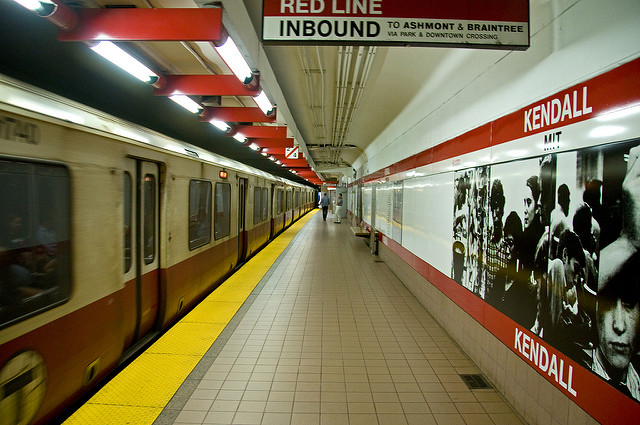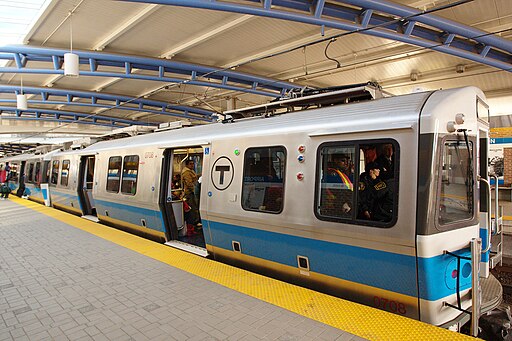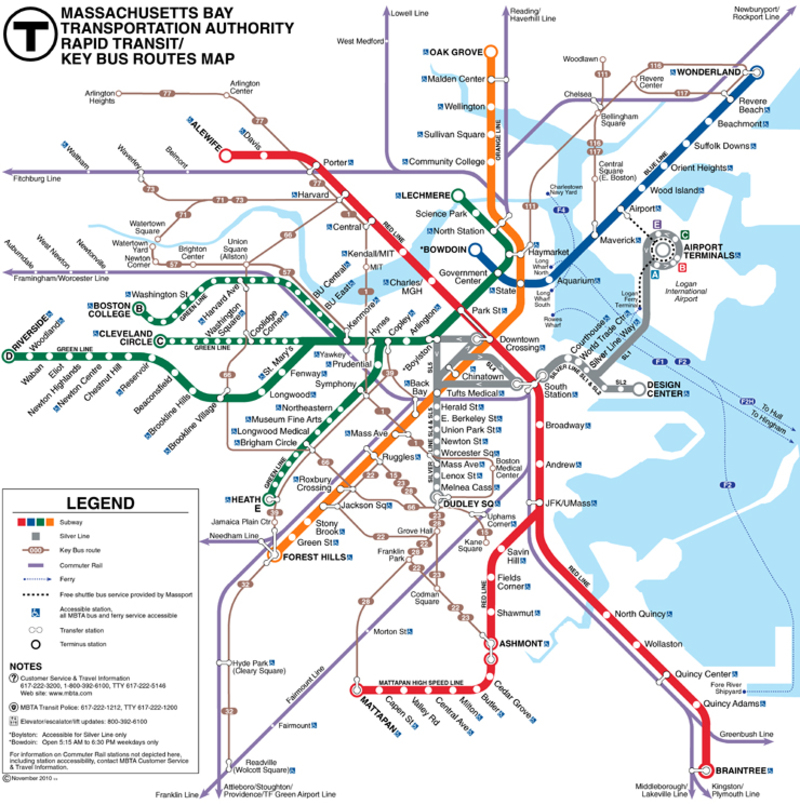Boston Metro is known as the “T” or just The Subway. It was built in 1897 and was the first subway system built in the United States. It's composed of 4 lines: orange, blue, red and green. On most days, service begins between 5:00 and 5:30 in the morning. The basic ticket or CharlieTicket is prized at $2.75. There are subscriptions available for students and seniors and children younger than 11 years old ride for free. The Boston subway is managed by the Massachusetts Bay Transportation Authority (MBTA). An interesting fact is that if the train is not full you're allowed to put your feet up on your seat. If you commit a crime that goes against the subway rules you can be banned for life.
Metros in United States: the Boston Subway
Boston is one of the oldest cities in the United States. The Boston metropolitan area has a population of approximately 4,500,000 inhabitants, making it one of the most populated urban areas in the country.
Located in the state of Massachusetts, it’s considered the financial, economic and cultural center of the New England region, in the northeast of the American union. Boston has a vast public transportation system to attend to the millions of workers that are on the move daily. The different ways to travel in the metropolis can be found under the administration of the Massachusetts Bay Transportation Authority (MBTA).
The locals know this system as the “T”, as its commercial logo is of this same letter, making it recognizable by any visitor as well. Included in the different ways of travel provided by the MBTA are, buses, light rail trains and the metro system, known to North Americans as the subway.
The Boston subway is the United States’ first underground system. Its inauguration took place 3 years prior to that of the worldwide known New York subway and 34 years after the one in London. Date of the year 1897. It was named a national historical monument.
The need for an underground system came as consequence of the overcrowding of the city's trolleys, which were not enough for the people anymore. Since 1900 it had an unprecedented expansion. The MBTA built more tunnels for the subway, the lines were extended throughout the center of the entire city, while also connecting the local communities through, not only the subway but also with the expansion of the railway and bus routes. There are also currently new plans of modernizing the system.
 Image via Eric Kilby
Image via Eric Kilby
Lines and stations
The Boston subway is composed of four lines, identified by the colors orange, blue, red and green.
Green Line
Inaugurated in 1897, it was the first of its type for the United States. It's composed of a fleet of superficial trains, that replaced the old tram, that for a very long time, circulated throughout the center of Boston. With 66 stations, a 37-km route and a daily demand of 230,000 users, its dimensions are such, that it divides into four tracts identified with the letters B, C, D and E, making it the largest of the “T” system. It unites the east with the center of the city, the towns of Brighton, Newton, Mission Hill and Jamaica Plan, are connected to this line in their different courses.
Orange Line
Inaugurated in 1901, it provides 19 stations that extend from the location of Jamaica Pain to Forest Hills, a length of 18km. Daily it’s used by more than 200,000 passengers. It unites the north with the southeast part of the city, passing through the center, where it makes transfers with the other three lines in different stations. All the stations of the Orange Line, are equipped with high-level platforms, with the thought of bringing access to handicapped people, while also having elevators that are provided with the same thought in mind.
Blue Line
It was the third line to start operating in 1904. It has 12 stations throughout its extended 9.7km, besides two more that are currently in construction. In this line’s case, its daily influx is calculated at approximately 67,000 users. It unites the neighborhood of East Boston, to the northeast of the city, with the center. It should be pointed out, that this line connects with Logan International Airport in Wonderland station, where passengers can take a bus to get them close to the air terminal.
Red Line
The Red Line, inaugurated in 1912, connects the north of Boston with the south zone. It is the most extensive line of the system with a total of 29 stations dispersed along 34km. It connects the neighborhood of North Cambridge to the north of the city at Alewife stop, with two different locations in the south. The path separates at JFK/UMass station, where some trains head towards Braintree and others towards the neighborhood of Dorchester.
Schedules
Each subway line has its own distinct schedule for departure, although most begin operating at around 5:00am to 5:30am from Monday through Saturday, while on Sundays they begin after 6:00am.
On the Red Line
The first train leaves at 5:24am from Alewife station, located in the northeast part of the city in the town of Cambridge, bound for the neighborhood of Braintree, while from the same station, but headed towards Ashmont terminal, in the historical neighborhood of Dorchester, it leaves at 5:16am. In reverse direction, from Braintree and Ashmont stations, bound for Alewife, the first trains leave at 5:15am and 5:16am, respectively. These schedules apply from Monday through Saturday. On Sundays, all the trains form the Red line begin operating at 6:00am. Also, the last train to provide commercial service leaves at the following times: Alewife-Braintree 12:15am, in reverse direction Braintree-Alewife 12:17am. Additionally, in the direction of Alewife-Ashmont 12:22am, in reserve direction Ashmont-Alewife 12:30am.
Schedules on the Blue Line
The first train on the Blue line from Wonderland station in the town of Revere, towards Bowdoin station in the center of Boston, leaves at 5:13am. And, in the direction of Bowdoin-Wonderland, at 5:29am. Schedules in place from Monday through Saturday. On Sundays, the departure time for Wonderland-Bowdoin is at 5:58am and Bowdoin-Wonderland 6:21am. The last train, from the neighborhood of Revere to the center of the city, leaves at 12:28am. In reverse direction, Bowdoin-Wonderland, at 1:00am.
Schedules for the Orange Line
The first trip leaves from Oak Grove en Malden station headed towards Forest Hills station, in Jamaica Plain, at 5:16am. In reverse direction, it follows the same schedule from Monday through Saturday. On Sundays, the first train leaves at 6:00am, in both directions. The last train leaves at 12:30am from Malden to Jamaica Plain and from Jamaica Plain to Malden, at 12:28am.
Schedules for the Green Line
The green line has various times of operation. Tract “B”, that goes from Boston College station in Brighton towards Park Street station in the center of Boston, leaves at 5:01am. In reverse direction, Park Street-Boston College, does so at 5:42am. Their last trains leave at 12:10am and 12:45am respectively in both directions: Boston College-Park Street and Park Street-Boston College.
Tract “C”, from Cleveland Circle station in Brighton to the North Station stop in the city’s Downtown, is at 5:01am and in reverse direction at 5:55am. The last trip from this tract leaves at 12:10am in the direction of Cleveland Circle-North Station, and at 12:46 in reverse direction.
Tract “D” of the Green line leaves at 4:56am from Riverside station in Newton towards the Government Center terminal in the center of Boston. In the opposite direction, the time of departure for the first train is at 5:41am. While, the last trip from this tract leaves at 12;05am from Newton to Downtown, and from Government Center station to Riverside at 12:49am.
In Tract “E”, the first train leaves at 5:38am from Heath Street station, located between the towns of Jamaica Plain and Mission Hill towards Lechmere station, in East Cambridge. Its last trip leaves at 12:47am from Heath Street-Lechmere and in the opposite direction at 12:30am.
MBTA Subway Rates
The Boston subway system offers different payment options that adapt to the needs of consumers. The basic pass, that consists of a ticket paid in cash, costs $2.75, and it’s known as CharlieTicket. Additionally, the MBTA provides their customers with a card known as the CharlieCard, which makes the trip cost $2.25. With this card one can also gain access to LinkPass plans, that are detailed below:
- Day LinkPass: It provides 24 hours of unlimited subway trips and unlimited use of local buses that are administered by the MBTA. It’s prized at $12. This is recommended for people that need to use public transportation, going from buses to trains, throughout an entire day.
- Week LinkPass: Like the previous one, it offers passengers unlimited trips in local trains and buses under MBTA administration, with a duration of 7 whole days from the moment of the first trip. It’s prized at $21.25. It’s especially convenient for tourists, whose stay will be between 7 and 15 days.
- Monthly LinkPass: For $84.50 monthly, the passenger will be able to enjoy 30 days of unlimited trips using the subway and bus lines administrated by MBTA. This is ideal for those that will be spending a long period of time in the city and will constantly need to use the public transportation system.
- Additional to the previous plans, the MBTA offers special prices for students and senior citizens. In the case of students, a Student CharlieCard is required. It’s a card dedicated to students from Elementary through High School age, that makes the trip cost $1.10. It’s valid for 30 days and is prized at $30. Senior citizens older than 65 years old can count on the same benefit, with a rate of $1.10 a trip and $30 for the monthly plan; the same prices apply to people with special needs. Children younger than 11 years travel totally free.
MBTA Subway regulations
Proper use of installations
- 1) While the Boston subway system doesn’t prohibit eating in the railway carriages, you can be admonished if your food gives out strong odors that present an annoyance to the other passengers.
- 2) Having conversations that are so loud that it disturbs the other passengers’ travels, can lead to being sanctioned by the system authorities.
- 3) Listening to loud music is not permitted in trains and stations of the subway.
- 4) If the wagon is empty, it is allowed to one’s feet up on the seats; however, during peak hours you may not improperly use the seats, as it may disturb other passengers and cause you to be sanctioned.
- 5) With the means of making the boarding onto the train go smoothly and quickly, it is recommended for passengers boarding to let the passengers departing the train walk out first before they board.
Bicycle Transport
- 1) Carry your bike to one side of your body, abstaining from using it in the system’s installations.
- 2) It is allowed to transport two bicycles per wagon. The owner of the bike would need to make sure that he’s not blocking the transit of other passengers in the hall and doors of the train.
- 3) If the train is too full, you would need to wait for another that has more space so that you may take your bike in with you.
- 4) In case of special events, the transport of bicycles in the trains can be prohibited. It is recommended to be alert to any unusual activity, from the city or organized by the MBTA.
- 5) Senior citizens and people with special needs have preference over bikes to use the trains.
- 6) In the case that a person of special needs requires a bike to improve their situation in the train, he would be allowed to have it with him in the installations at all times.
- 7) Cyclists that are younger than 16 years old, should be accompanied by a legal representative, in the subway’s installations.
- 8) Passengers that do not follow the previous indications could be banned for life from using the services provided by the MBTA.
Transport of Pets
- 1) During hours of low influx of people, you will be able to travel with your pet without any inconvenience. During peak hours, the boarding of animals could be restricted.
- 2) Dogs must be on a leash and be wearing a muzzle and may not occupy seats in the carriage. Also, they should not disturb the peace of other passengers.
- 3) During peak hours, smaller animals should be transported in appropriate cages, in the means of not disturbing other passengers.
- 4) The owner will be held accountable for all the damages that a pet may cause inside the installations of the subway, and will also have to pay a ticket for the damages.
Security
The Boston subway has its own security force called the MBTA Transit Police Department. They’re in charge of assisting in keeping passengers safe and helping them with their complaints. They have the right to carry out investigations, as well as arrests in the case of illicit acts inside the transportation system. They have a team that is specialized in sexual harassment cases in the trains, either physical or verbal, which they pay a of attention to. Their service is highly qualified when it comes to taking care of any incident that may put at risk the passenger’s integrity.
Airport connection
You may travel to Logan International Airport in a simple and convenient way, using the blue line of the subway. You must take a train in direction to Airport station, where when leaving the terminal, you will have buses available that are identified with the name of the company known as Massport, that oversee the airport’s logistics. The trip takes between 10 to 15 minutes, and is completely free.
In the opposite case, if you travel from the airport to the center of the city by subway, you will have to take one of these bus lines: no. 22, 33 or 55 in direction to the Blue line of the subway system. All vehicles are identified with the name of the company called Massport, located to the south of the air terminal, right outside the entrance.
It also should be mentioned that in the airport you will have available the Silver line that does not have to do with the subway, but is a fast way of connecting to the city. It’s a system of articulated buses, that circulate through fast transit channels in the city, and that make connections with the Red, Blue and Green lines of the Boston subway. If you board this system in the air terminal, the trip will be free. In the opposite case, if using this line to get to the airport, you will be charged $2.00 per trip.
Future expansions
There is currently a request to extend the Blue line to the neighborhood of Lynn to the north of the city. At the same time, it is planned to have a connection in the south with the Red line in its west tract. On the other side, the Green line also has plans of expanding to the north towards the neighborhoods of Somerville and Medford, relocating Lechmere station and ending the road that unites both sectors. It is estimated that this last project will cost three thousand million dollars, and would be inaugurated towards the end of 2021.
Additional to the projects with the Blue and Green lines, an urban ring is expected to be built in the center of the city and it will unite bus routes, subway stops and railway terminals, which would provide the user fast travel between systems.
Places of interest
The first place that you must visit if you’re in the city of Boston is the Waterfront, located right outside the Aquarium station of the Blue line. It’s a dock with breathtaking views over the city’s port, that also captivates the panoramic views of the center and its skyscrapers. It’s a wonderful place to spend an afternoon doing something different, contemplating the Boston architecture.
Also in the same station, a few meters from the Waterfront, you can find the New England Aquarium. It’s an aquarium with exhibits including thousands of marine species, distributed into sections such as Sharks and Rays, Turtles Uncovered or Penguin Power. It’s a place that must be visited by locals and tourists for its ample variety of specimens, and also for offering recreational activities that allow visitors to interact with certain species under the supervision of someone in management.
Another destination that must not be overlooked is the Museum of Fine Arts accessible from Green line. It has the second largest artistic exposition in the United States, surpassed only by the Metropolitan Museum of Art of New York, which makes it one of the most symbolic museums of the north American country. It was founded in 1876, it exhibits collections of Egyptian antiquities, paintings of French impressionism and post-impressionists, Chinese art and paintings, Japanese creations and a section dedicated to the Rothschild family, from Austria. Likewise, it has a library with more than 320,000 books.
Boston The T map
- Also Known As: The T
- Passengers/Day 1100000
- Fares: gates, smartcard
- 24h operation: No
- Air Conditioning: Yes
- Walk between platforms: No
- Driverless trains: No
- Screen Doors Platforms: No
- Operator: MBTA
- 1100000
- Boston Metro Official Website
- Tlf: +1 617 222 3200
Help us
If you consider that the information we provide is wrong, not accurated, outdated, translation contains errors, and you would like to help us to improve the file...you can contact us here.
Feel free to contact us if you dont find the system you're looking for and we'll add it as soon as we can!
Thank you very much!










